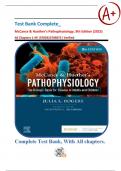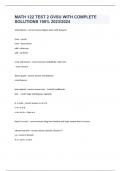Test Bank Complete_
McCance & Huether’s Pathophysiology, 9th Edition (2023)
All Chapters 1-49 |9780323789875| Verified
,UNIT I; The Cell _____________________________________________________________ 4
Chapter 01: Cellular Biology_______________________________________________________ 4
Chapter 02: Altered Cellular And Tissue Biology: Environmental Agents __________________ 20
Chapter 03: The Cellular Environment: Fluids And Electrolytes, Acids And Bases ___________ 35
UNIT II; Genes and Gene-Environment Interaction ________________________________ 50
Chapter 04: Genes And Genetic Diseases ___________________________________________ 50
Chapter 05: Genes, Environment-Lifestyle, And Common Diseases ______________________ 62
Chapter 06: Epigenetics And Disease ______________________________________________ 71
UNIT III; Mechanisms of Self-Defense __________________________________________ 76
Chapter 07: Innate Immunity: Inflammation And Wound Healing _______________________ 76
Chapter 08: Adaptive Immunity __________________________________________________ 92
Chapter 09: Alterations In Immunity ______________________________________________ 105
Chapter 10: Infection __________________________________________________________ 119
Chapter 11: Stress And Disease __________________________________________________ 129
UNIT IV; Cellular Proliferation: Cancer ________________________________________ 137
Chapter 12: Cancer Biology _____________________________________________________ 137
Chapter 13: Cancer Epidemiology ________________________________________________ 151
Chapter 14: Cancer in Children and Adolescents ____________________________________ 158
UNIT V; The Neurologic System ______________________________________________ 164
Chapter 15: Structure And Function Of The Neurologic System ________________________ 164
Chapter 16: Pain, Temperature Regulation, Sleep, And Sensory Function ________________ 176
Chapter 17: Alterations In Cognitive Systems, Cerebral Hemodynamics, And Motor Function 191
Chapter 18: Alterations of the Brain, Spinal Cord, and Peripheral Nerves ________________ 206
Chapter 19: Neurobiology of Schizophrenia, Mood Disorders, Anxiety Disorders, Posttraumatic
Stress Disorder, and Obsessive-Compulsive Disorder ________________________________ 218
Chapter 20: Alterations Of Neurologic Function In Children ___________________________ 225
UNIT VI; The Endocrine System ______________________________________________ 233
Chapter 21: Mechanisms Of Hormonal Regulation __________________________________ 233
Chapter 22: Alterations Of Hormonal Regulation ____________________________________ 243
Chapter 23: Obesity, Starvation, and Anorexia of Aging ______________________________ 257
UNIT VII; The Reproductive Systems __________________________________________ 263
Chapter 24: Structure And Function Of The Reproductive Systems______________________ 263
Chapter 25: Alterations Of The Female Reproductive System __________________________ 274
Chapter 26: Alterations Of The Male Reproductive System ____________________________ 285
, Chapter 27: Sexually Transmitted Infections _______________________________________ 292
UNIT VIII; The Hematologic System ___________________________________________ 301
Chapter 28: Structure And Function Of The Hematologic System _______________________ 301
Chapter 29: Alterations Of Hematologic Function ___________________________________ 312
Chapter 30: Alterations Of Hematologic Function In Children __________________________ 323
UNIT IX; The Cardiovascular and Lymphatic Systems _____________________________ 335
Chapter 31: Structure And Function Of The Cardiovascular And Lymphatic Systems ________ 335
Chapter 32: Alterations Of Cardiovascular Function _________________________________ 349
Chapter 33: Alterations Of Cardiovascular Function In Children ________________________ 365
UNIT X; The Pulmonary System ______________________________________________ 374
Chapter 34: Structure And Function Of The Pulmonary System ________________________ 374
Chapter 35: Alterations Of Pulmonary Function _____________________________________ 385
Chapter 36: Alterations Of Pulmonary Function In Children ___________________________ 403
UNIT XI; The Renal and Urologic Systems ______________________________________ 413
Chapter 37: Structure And Function Of The Renal And Urologic Systems _________________ 413
Chapter 38: Alterations Of Renal And Urinary Tract Function __________________________ 424
Chapter 39: Alterations Of Renal And Urinary Tract Function In Children ________________ 435
UNIT XII; The Digestive System ______________________________________________ 443
Chapter 40: Structure and Function of the Digestive System, 1285 ______________________ 443
Chapter 41: Alterations Of Digestive Function ______________________________________ 456
Chapter 42: Alterations Of Digestive Function In Children _____________________________ 467
UNIT XIII; The Musculoskeletal System ________________________________________ 478
Chapter 43: Structure And Function Of The Musculoskeletal System ____________________ 478
Chapter 44: Alterations Of Musculoskeletal Function ________________________________ 491
Chapter 45: Alterations Of Musculoskeletal Function In Children _______________________ 505
UNIT XIV; The Integumentary System _________________________________________ 515
Chapter 46: Structure, Function, And Disorders Of The Integument _____________________ 515
Chapter 47: Alterations Of The Integument In Children _______________________________ 528
UNIT XV; Multiple Interacting Systems ________________________________________ 537
Chapter 48: Shock, Multiple Organ Dysfunction Syndrome, And Burns In Adults __________ 537
Chapter 49: Shock, Multiple Organ Dysfunction Syndrome, And Burns In Children _________ 545
,PART ONE: CENTRAL CONCEPTS OF PATHOPHYSIOLOGY: CELLS AND TISSUES
UNIT I; The Cell
Chapter 01: Cellular Biology
Rogers: Mccance & Huether’s Pathophysiology, 9th Edition, (2023) Test Bank
MULTIPLE CHOICE
1. Which Statement Best Describes The Cellular Function Of Metabolic Absorption?
A. Cells Can Produce Proteins.
B. Cells Can Secrete Digestive Enzymes.
C. Cells Can Take In And Use Nutrients.
D. Cells Can Synthesize Fats.
ANS: C
In Metabolic Absorption, All Cells Take In And Use Nutrients And Other Substances
From Their Surroundings. The Remaining Options Are Not Inclusive In Their
Descriptions Of Cellular Metabolic Absorption.
DIF: Cognitive Level: Remembering
2. Where Is Most Of A Cell’s Genetic Information, Including Rna And DNA,
Contained?
A. Mitochondria
B. Ribosome
C. Nucleolus
D. Lysosome
ANS: C
The Nucleus Contains The Nucleolus, A Small Dense Structure Composed Largely
Of RNA, Most Of The Cellular DNA, And The DNA-Binding Proteins, Such As The
Histones, Which Regulate Its Activity. The Mitochondria Are Responsible For
Cellular Respiration And Energy Production.
Ribosomes’ Chief Function Is To Provide Sites For Cellular Protein Synthesis.
Lysosomes Function As The Intracellular Digestive System.
DIF: Cognitive Level: Remembering
3. Which Component Of The Cell Produces Hydrogen Peroxide (H2o2) By Using
Oxygen To Remove Hydrogen Atoms From Specific Substrates In An Oxidative
Reaction?
,A. Lysosomes
B. Peroxisomes
C. Ribosomes
D. Endosome
ANS: B
Peroxisomes Are So Named Because They Usually Contain Enzymes That Use
Oxygen To Remove Hydrogen Atoms From Specific Substrates In An Oxidative
Reaction That Produces H2o2, Which Is A Powerful Oxidant And Potentially
Destructive If It Accumulates Or Escapes From Peroxisomes. Ribosomes Are Rna-
Protein Complexes (Nucleoproteins) That Are Synthesized In The Nucleolus And
Secreted Into The Cytoplasm Through Pores In The Nuclear Envelope Called Nuclear
Pore Complexes. Lysosomes Are Saclike Structures That Originate From The Golgi
Complex And Contain More Than 40 Digestive Enzymes Called Hydrolases, Which
Catalyze Bonds In Proteins, Lipids, Nucleic Acids, And Carbohydrates. An
Endosome Is A Vesical That Has Been Pinched Off From The Cellular Membrane.
DIF: Cognitive Level: Remembering
4. Which Cell Component Is Capable Of Cellular Autodigestion When It Is Released
During Cell Injury?
A. Ribosome
B. Golgi Complex
C. Smooth Endoplasmic Reticulum
D. Lysosomes
ANS: D
The Lysosomal Membrane Acts As A Protective Shield Between The Powerful
Digestive Enzymes Within The Lysosome And The Cytoplasm, Preventing Their
Leakage Into The Cytoplasmic Matrix. Disruption Of The Membrane By Various
Treatments Or Cellular Injury Leads To A Release Of The Lysosomal Enzymes,
Which Can Then React With Their Specific Substrates, Causing Cellular Self-
Digestion. The Chief Function Of A Ribosome Is To Provide Sites For Cellular
Protein Synthesis. The Golgi Complex Is A Network Of Flattened, Smooth Vesicles
And Membranes Often Located Near The Cell Nucleus. The Smooth Endoplasmic
Reticulum Is Involved In Steroid Hormone Production And Removing Toxic
Substances From The Cell.
DIF: Cognitive Level: Remembering
5. Which Camp-Mediated Response Is Related To Antidiuretic Hormone?
A. Increased Heart Rate And Force Of Contraction
B. Secretion Of Cortisol
C. Increased Retention Of Water
D. Breakdown Of Fat
, ANS: C
Antidiuretic Hormone Leads To Increased Retention Of Water In The Body.
Epinephrine Causes Increases In Heart Rate And Force Of Contraction. Increased
Cortisol Secretion Is Due To Acth. Breakdown Of Fat Is Due To Glucagon.
DIF: Cognitive Level: Remembering
6. During Which Phase Of The Cell Cycle Is DNA Synthesized?
A. G1
B. S
C. G2
D. M
ANS: B
The Four Designated Phases Of The Cell Cycle Are: (1) The G1 Phase (G = Gap),
Which Is The Period Between The M Phase (M = Mitosis) And The Start Of DNA
Synthesis; (2) The S Phase (S
= Synthesis), During Which DNA Is Synthesized In The Cell Nucleus; (3) The G2
Phase, During Which Rna And Protein Synthesis Occurs, The Period Between The
Completion Of DNA Synthesis And The Next Phase (M); And (4) The M Phase,
Which Includes Nuclear And Cytoplasmic Division.
DIF: Cognitive Level: Remembering
7. What Organic Compound Facilitates Transportation Across Cell Membranes By
Acting As Receptors, Transport Channels For Electrolytes, And Enzymes To Drive
Active Pumps?
A. Lipids
B. Proteases
C. Proteins
D. Carbohydrates
ANS: C
Proteins Have Several Functions, Including Acting As Receptors, Transport Channels
For Electrolytes, And Enzymes To Drive Active Pumps Lipids Help Act As The
―Glue‖ Holding Cell Membranes Together. Proteases Cause The Breakdown Of
Protein. Carbohydrates Are Involved In Cellular Protection And Lubrication And
Help Produce Energy Via Oxidative Phosphorylation.
DIF: Cognitive Level: Remembering
8. Understanding The Various Steps Of Proteolytic Cascades May Be Useful In
Designing Drug Therapy For Which Human Diseases?
A. Cardiac And Vascular Disorders
B. Autoimmune And Malignant Disorders
C. Gastrointestinal And Renal Disorders





